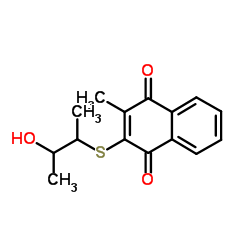Cathepsin D, from bovine spleen

Cathepsin D, from bovine spleen structure
|
Common Name | Cathepsin D, from bovine spleen | ||
|---|---|---|---|---|
| CAS Number | 9025-26-7 | Molecular Weight | 276.351 | |
| Density | 1.3±0.1 g/cm3 | Boiling Point | 432.4±45.0 °C at 760 mmHg | |
| Molecular Formula | C15H16O3S | Melting Point | N/A | |
| MSDS | Chinese USA | Flash Point | 215.3±28.7 °C | |
|
4-tert-Octylphenol stimulates the expression of cathepsins in human breast cancer cells and xenografted breast tumors of a mouse model via an estrogen receptor-mediated signaling pathway.
Toxicology 304 , 13-20, (2013) Endocrine disrupting chemicals (EDCs) are defined as environmental compounds that modulate steroid hormone receptor-dependent responses an abnormal manner, resulting in adverse health problems for humans such as cancer growth and metastasis. Cathepsins are pr... |
|
|
A periodate-cleavable linker for functional proteomics under slightly acidic conditions: application for the analysis of intracellular aspartic proteases.
J. Proteome Res. 12(1) , 199-207, (2013) Specific elution of captured proteins greatly improves the quality of proteomic data obtained from pull-downs by avoiding signals from nonspecific proteins, thus allowing more sensitive identification of target proteins. This is important in activity-based pr... |
|
|
Acetate-induced apoptosis in colorectal carcinoma cells involves lysosomal membrane permeabilization and cathepsin D release.
Cell Death Dis. 4 , e507, (2013) Colorectal carcinoma (CRC) is one of the most common causes of cancer-related mortality. Short-chain fatty acids secreted by dietary propionibacteria from the intestine, such as acetate, induce apoptosis in CRC cells and may therefore be relevant in CRC preve... |
|
|
Role of cathepsin D in U18666A-induced neuronal cell death: potential implication in Niemann-Pick type C disease pathogenesis.
J. Biol. Chem. 288(5) , 3136-52, (2013) Cathepsin D is an aspartyl protease that plays a crucial role in normal cellular functions and in a variety of neurodegenerative disorders, including Niemann-Pick type C (NPC) disease, which is characterized by intracellular accumulation of cholesterol and gl... |
|
|
Hyperplex-MRM: a hybrid multiple reaction monitoring method using mTRAQ/iTRAQ labeling for multiplex absolute quantification of human colorectal cancer biomarker.
J. Proteome Res. 12(9) , 3912-9, (2013) Novel biomarker verification assays are urgently required to improve the efficiency of biomarker development. Benefitting from lower development costs, multiple reaction monitoring (MRM) has been used for biomarker verification as an alternative to immunoassa... |
|
|
Proteolysis and cathepsin activities in the processing of dry-cured duck.
Poult. Sci. 93(3) , 687-94, (2014) Changes in sarcoplasmic and myofibrillar proteins, free amino acids, and cathepsin activities were measured to evaluate the contribution of cathepsins to the proteolysis of muscle proteins in dry-cured duck processing. Thirty-six dry-cured ducks were processe... |
|
|
Impairment of autophagic flux promotes glucose reperfusion-induced neuro2A cell death after glucose deprivation.
PLoS ONE 8(10) , e76466, (2013) Hypoglycemia-induced brain injury is a common and serious complication of intensive insulin therapy experienced by Type 1 diabetic patients. We previously reported that hypoglycemic neuronal death is triggered by glucose reperfusion after hypoglycemia rather ... |
|
|
Identification of pathogenic T cell epitopes near cathepsin cleavage sites in thyroglobulin.
J. Immunol. 190(4) , 1466-71, (2013) Experimental autoimmune thyroiditis, induced in mice after challenge with thyroglobulin (Tg), is known to be under the genetic control of the H2A(k) locus. Because cathepsins are known to influence proteolytic processing of Tg in vivo, we examined in this stu... |
|
|
Patulin induces pro-survival functions via autophagy inhibition and p62 accumulation.
Cell Death Dis. 4 , e822, (2013) Patulin (PAT) is one of the most common mycotoxins found in moldy fruits. Skin contact is one of the most likely exposure routes of PAT. Investigation of dermal toxicity of PAT is clearly needed and has been highlighted by WHO. In the present study, using hum... |
|
|
Over-expression of an inactive mutant cathepsin D increases endogenous alpha-synuclein and cathepsin B activity in SH-SY5Y cells.
J. Neurochem. 128(6) , 950-61, (2014) Parkinson's disease is a neurodegenerative movement disorder. The histopathology of Parkinson's disease comprises proteinaceous inclusions known as Lewy bodies, which contains aggregated α-synuclein. Cathepsin D (CD) is a lysosomal protease previously demonst... |